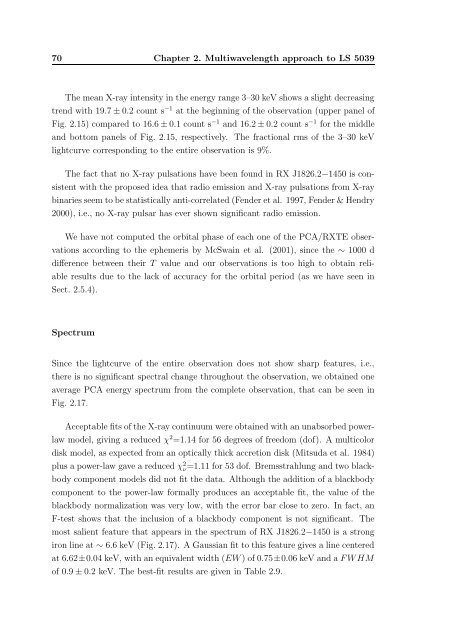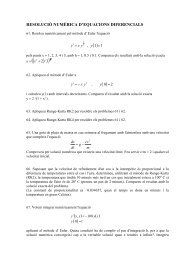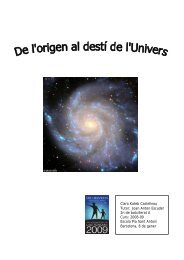Universitat de - Departament d'Astronomia i Meteorologia ...
Universitat de - Departament d'Astronomia i Meteorologia ...
Universitat de - Departament d'Astronomia i Meteorologia ...
You also want an ePaper? Increase the reach of your titles
YUMPU automatically turns print PDFs into web optimized ePapers that Google loves.
70 Chapter 2. Multiwavelength approach to LS 5039<br />
The mean X-ray intensity in the energy range 3–30 keV shows a slight <strong>de</strong>creasing<br />
trend with 19.7 ± 0.2 count s −1 at the beginning of the observation (upper panel of<br />
Fig. 2.15) compared to 16.6 ± 0.1 count s −1 and 16.2 ± 0.2 count s −1 for the middle<br />
and bottom panels of Fig. 2.15, respectively. The fractional rms of the 3–30 keV<br />
lightcurve corresponding to the entire observation is 9%.<br />
The fact that no X-ray pulsations have been found in RX J1826.2−1450 is con-<br />
sistent with the proposed i<strong>de</strong>a that radio emission and X-ray pulsations from X-ray<br />
binaries seem to be statistically anti-correlated (Fen<strong>de</strong>r et al. 1997, Fen<strong>de</strong>r & Hendry<br />
2000), i.e., no X-ray pulsar has ever shown significant radio emission.<br />
We have not computed the orbital phase of each one of the PCA/RXTE obser-<br />
vations according to the ephemeris by McSwain et al. (2001), since the ∼ 1000 d<br />
difference between their T value and our observations is too high to obtain reli-<br />
able results due to the lack of accuracy for the orbital period (as we have seen in<br />
Sect. 2.5.4).<br />
Spectrum<br />
Since the lightcurve of the entire observation does not show sharp features, i.e.,<br />
there is no significant spectral change throughout the observation, we obtained one<br />
average PCA energy spectrum from the complete observation, that can be seen in<br />
Fig. 2.17.<br />
Acceptable fits of the X-ray continuum were obtained with an unabsorbed power-<br />
law mo<strong>de</strong>l, giving a reduced χ 2 =1.14 for 56 <strong>de</strong>grees of freedom (dof). A multicolor<br />
disk mo<strong>de</strong>l, as expected from an optically thick accretion disk (Mitsuda et al. 1984)<br />
plus a power-law gave a reduced χ2 ν =1.11 for 53 dof. Bremsstrahlung and two blackbody<br />
component mo<strong>de</strong>ls did not fit the data. Although the addition of a blackbody<br />
component to the power-law formally produces an acceptable fit, the value of the<br />
blackbody normalization was very low, with the error bar close to zero. In fact, an<br />
F-test shows that the inclusion of a blackbody component is not significant. The<br />
most salient feature that appears in the spectrum of RX J1826.2−1450 is a strong<br />
iron line at ∼ 6.6 keV (Fig. 2.17). A Gaussian fit to this feature gives a line centered<br />
at 6.62±0.04 keV, with an equivalent width (EW ) of 0.75±0.06 keV and a F W HM<br />
of 0.9 ± 0.2 keV. The best-fit results are given in Table 2.9.






